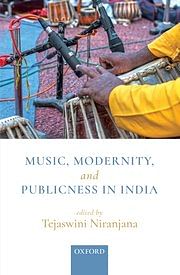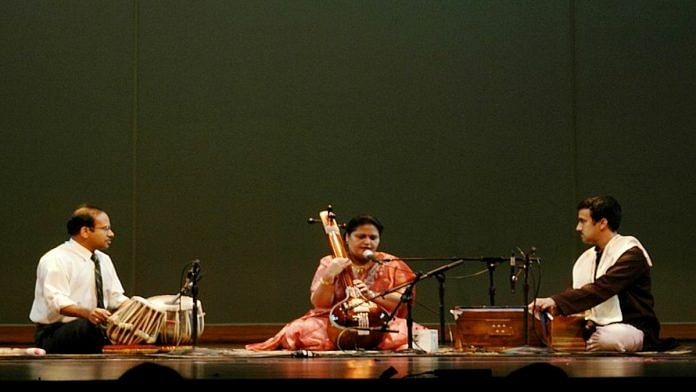Who were the new listeners? When were new music associations or sabhas formed and what was their raison d’etre? Recent social histories of music in India have emphasized the importance of colonial cities spawning new middle-class listeners whose enthusiasm sustained performers and musicians who were displaced from older patronage spaces and made their way to cities such as Madras. The colonial cities (notably Calcutta, Bombay, and Madras) were not only able to absorb influx of musicians and performers who moved out of their older centres of patronage (courts and salons) but were able to sustain new and emerging forms of musical entertainment, and technology, thereby becoming exciting spaces of listening and desire.
Listeners, mostly upper castes, Brahmins and Vellalas who traditionally featured as patrons and performers in the city replicated spaces of performance but with noticeable differences. Performances were organized in public spaces sponsored by the associations they formed to promote musical performances supported by tickets and subscriptions. Madras by the end of the nineteenth century and the first quarter of the twentieth century saw a proliferation of sabha(s) or music associations that started off as small meeting places for religious discourses (harikatha), subsequently organized stand-alone music concerts, of musical soirees in the houses of patrons and performers.
What stands out in the survey made by the L’Armands on the basis of references to sabha culture and activities in the local newspaper, The Hindu, was the vitality of the entertainment scene, a predominantly musical one, and the close association of sabha culture with the circuits of religious festivity that involved music. Clearly, listening to music in the early days of sabha culture was both part of an older habit of participation in religious practices that included music and performance, as well as of making and marking it as a form of high entertainment.
Also Read: How as a young boy, Hariprasad Chaurasia came to choose music over wrestling, flute over sitar
Early on, therefore, there was no clear sundering of music as religious and secular one except in relation to the sites in which these were performed. But that changed, as religious discourses and performances gave way to standalone music concerts that were seen as an important form of high culture entertainment, which demanded attentive listening, and exemplary standards. The spatial restructuring of music thus became important; for it was here that a new set of possibilities emerged for articulating a standard for taste and for a systematic repertoire for public concerts.
By the 1930s the religious associations waned and sabhas emerged as the major connoisseurs and patrons of classic music performances and concerts. As the work of L’Armand and L’Armand clearly demonstrated, the number of harikatha performances had dropped dramatically by 1938, sabhas gave up their role as organizers of religious functions and focused on arranging music concerts. There was also an increase in the popularity of vocal performances; the L’Armand estimates refer to an increase in numbers from 14 public vocal concerts from 1898 to 69 in 1928, to 170 in 1948 and to 310 in 1968. The shift away from harikatha performances to standalone public concerts that attracted larger numbers of listeners who were prepared to attend ticketed performances persuaded sabha organizers to combine the roles of entrepreneur and publicist, to take the initiative in debating standards for performance and conventions for listeners.
Many connoisseurs, even sabha organizers, shared their experiences in writing, thereby producing a community of shared readers/listeners whose interlocution was decisive in consolidating the musical public. In producing aesthetic values, the recourse to both imperatives of social etiquette as well as of interiorized appreciation was obvious. The lexicon adopted predictably emphasized ideas of standards, of a new soundscape that played down excessive rhythmic displays and emphasized the primacy of emotionalism (bhava) in musical rendering and interpretation.
Also Read: India’s ‘shy’ classical musicians made way for theatre’s entry into gramophone record books
Sabha(s) or music associations were thus pivotal to the cohering of a public sphere for music in twentieth century Madras. As P.S. Iyer in his 1921 address before the Academy of Karnatik Music pointed out, ‘It is obvious on the very face of it that it is this Academy of Karnatik Music and these Sangeetha Sabhas that ought to give the lead to the whole of Southern India in the matter of our musical development and especially in arriving at and fixing that common standard.
What Madras does today, the rest of the presidency will come to do in course of time. It is from here that all movements, political, social or musical will come to do in course of time. Besides so far as I know there are no Sabhas or Academies of the kind that we have here in the mofussil, therefore, it is not too much to hope that our Academy and our Sangeetha sabhas will take the initiative in this matter. They ought to do it for this; if for no other reason, that no other organization can do it. If they too fail to do it, will not the public (italics mine) lay at their doors the charge that they are guilty of a gross dereliction of duty?
Like so many others of his class and orientation, Iyer was gesturing to the importance of a public he understood in terms of a social collective, whose interests had to be safeguarded by undertaking a reform effort that would preserve and rejuvenate a musical tradition, whose artistic and moral worth was vital for both the immediate constituency of listeners as well as for the larger entity of the nation that was being forged. The ‘public’ here was a discursive space constituted by publicists such as Iyer himself to work for a common mutual interest, and wherein concrete suggestions and practices could enable a rational sociability and critique. Evidently at one level, this was a far cry from older spaces of temples, where people met to listen to music, were moved by it and saw it as an extension of a personalized experience of devotion. They were also distinct from court and salon displays where music duels were common, carrying with them important connotations of individual patronage, discretion, and taste. The new public was obviously different from both these spaces and represented an actual and discursive space where the performer and the audience worked in tandem to consolidate an aesthetic.
Iyer was especially eloquent in this regard, founding the Academy of Karnatik Music, he said he hoped that his academy would ‘give lead to the whole of southern India in arriving and fixing a common standard. There are a few men in the sabhas who are justly regarded as musical experts. These men should hold a preliminary meeting for the purpose of settling certain details as to the way musical reform should be carried out as to evolve a common standard out of the welter of popular tastes that prevails at the present’. In a similar vein, Abraham Pandithar, organizer of the Tanjore Sangeet Vidya Sangam, expressed his intention of researching the principles of melody and microtones more carefully and found it necessary to organize a ‘sabha of vidwans so that they may be systematized’. Pandithar was equally interested in local musical practices and Tamil compositions that had been forgotten.
The logic of reform was thus built into the sabhas as they assumed the responsibility of producing if not a common taste a common set of standards that would guide the presentation of a classical concert. It was the structuring of the concert, its repertoire, its potential as a means of communicating the veracity of an established lineage and style that was at the heart of their project that surprisingly did not take long to cohere or win the confidence of the actual artistes and performers. The first sabhas were tentative and had to go through a correction course by the mid-1920s when there was a music boom of sorts and when there was too much music available and a lot if it was seen as below standard. There was thus a hungry public for aural stimulation, eager to listen to a range of music from theatre music to early Carnatic concerts making it all the more essential to define a classical tradition and style.
By 1929, the leading members of the existing sabhas and important public personages and the professional elite of Madras city met to discuss the possibility of forming a larger federation of associations that would enable successful arrangement of concerts on a commercial basis, of endorsing a set of standards to develop and refine a distinct classical style for public concerts in the city. The federation was not thought of as a grand cartel; just a loose coming together of the city sabhas working towards a common schedule of concerts, of setting certain minimum standards for public concerts (in terms of repertoire, etiquette, and accompaniment conventions) that would eventually produce and consolidate a new mode of performing and listening within an expanded milieu of socialization that was seen as a key site for self-definition and social identity.
This ideal was realized in the form of the Madras Music Academy (established in 1929) that came into being as a professional body that not only sponsored concerts but encouraged open and active discussion among experts who were constituted as an Experts Committee that would debate technical musical issues within the framework of modern protocols and associational practices.
 This excerpt from Music, Modernity, and Publicness in India edited by Tejaswini Niranjana has been published with permission from Oxford University Press.
This excerpt from Music, Modernity, and Publicness in India edited by Tejaswini Niranjana has been published with permission from Oxford University Press.




It is hightime that Doordarshan provides a 24 x 7 HD channel for Indian classical music so that music is preserved
and classic muscians are rewarded. This will act as a bulwark against global corporates like Youtube, Spotify etc. Just act
before it is too late. The huge library is also better utilised.